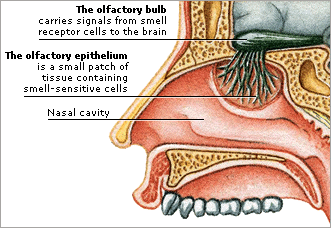DK Human Body: Nose
The main entrance to the body’s airways is the nose. It also contains our smell sensors. The outer part of the nose is made mostly of a rubbery tissue called cartilage.
Breathing through the nose helps to protect the tissues of the lungs from germs, dirt, and very dry or cold air. The moist lining of the nasal passages warms and moistens air. Sticky mucus traps particles of dust, soot, and bacteria. Tiny beating hairs, called cilia, drive the mucus toward the throat to be swallowed.
In the roof of each nostril is a patch of nerve endings, called the olfactory epithelium, covered by mucus. Odor molecules dissolve in the mucus and stimulate the nerve endings, which send signals to the olfactory bulb and the brain. We can recognize more than 10,000 smells and detect just a few molecules of some odors in a breath of air.

